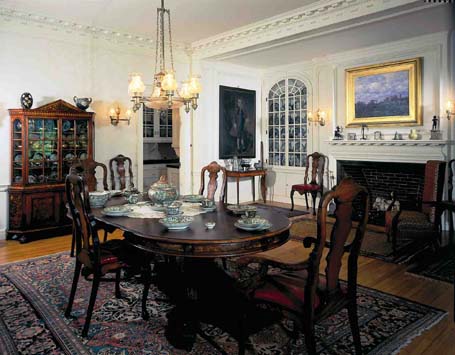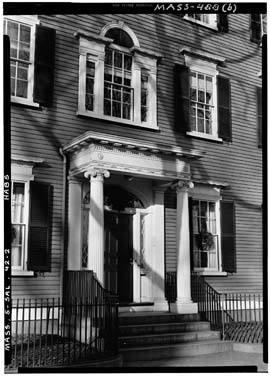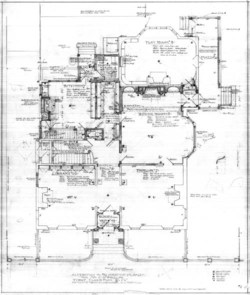
 Interior Phillips House dining room, courtesy of Historic New EnglandIn the ten years I’ve lived in Salem, I’ve rarely missed Historic Salem, Inc.’s Christmas in Salem house tour. Each year it presents new opportunities to share the stories of Salem’s most intriguing historic homes and properties, all decorated for the season. The 32nd annual tour invites attendees to “Rediscover the McIntire District” – the notable historic neighborhood named for Samuel McIntire, Salem’s famed late 18th and early 19th century wood-carver architect. If you think you know the McIntire District, think again. Among 13 featured properties, this year’s tour will highlight the Colonial Revival architecture of Salem-native, William G. Rantoul.
Interior Phillips House dining room, courtesy of Historic New EnglandIn the ten years I’ve lived in Salem, I’ve rarely missed Historic Salem, Inc.’s Christmas in Salem house tour. Each year it presents new opportunities to share the stories of Salem’s most intriguing historic homes and properties, all decorated for the season. The 32nd annual tour invites attendees to “Rediscover the McIntire District” – the notable historic neighborhood named for Samuel McIntire, Salem’s famed late 18th and early 19th century wood-carver architect. If you think you know the McIntire District, think again. Among 13 featured properties, this year’s tour will highlight the Colonial Revival architecture of Salem-native, William G. Rantoul.
Great grandson of Robert Rantoul, Sr. (for whom Rantoul Street is named in Beverly), architect William G. Rantoul left his stamp on many formidable buildings on the North Shore. Lucky for us, several of them are featured on the Christmas in Salem tour, including the c. 1906 Salem Athenaeum, c. 1911 renovations to Historic New England’s Phillips House, and two private residences from roughly the same period. Flags will mark these and additional properties on the tour route which have Rantoul connections.
 Phillips House. Library of Congress, Prints & Photographs Division, HABS MASS,5-SAL,42-2 Perhaps the best way to get a taste, here, for this year’s tour and for Rantoul’s architecture is to explore Historic New England’s Phillips House at 34 Chestnut Street. It exemplifies much of Rantoul’s work in the Colonial Revival style. In 1911 Anna and Stephen Willard Phillips hired their family friend, peer, and Chestnut Street neighbor, architect William G. Rantoul, to renovate their home in a manner more in keeping with its original Federal era roots.
Phillips House. Library of Congress, Prints & Photographs Division, HABS MASS,5-SAL,42-2 Perhaps the best way to get a taste, here, for this year’s tour and for Rantoul’s architecture is to explore Historic New England’s Phillips House at 34 Chestnut Street. It exemplifies much of Rantoul’s work in the Colonial Revival style. In 1911 Anna and Stephen Willard Phillips hired their family friend, peer, and Chestnut Street neighbor, architect William G. Rantoul, to renovate their home in a manner more in keeping with its original Federal era roots.
Those roots hark back to Oak Hill, a c. 1800 home designed by Samuel McIntire for Captain Nathaniel West and his wife Elizabeth Derby West in South Danvers, Massachusetts. After a bitter divorce in 1806, Elizabeth retained the property until her death in 1814. She left the estate to their three daughters, but when Sarah, the youngest, perished unmarried and childless in 1819, Nathaniel West inherited Sarah’s third of the estate. He did the logical thing, and in 1820 had his third, which amounted to four rooms (two stacks of two rooms), removed from Oak Hill and moved by ox sled to Salem. He then had a hall added between the rooms on the first and second floors, a third floor constructed on top, and a back ell attached. Voilà, Federal home.
Later owners, including the Webb family in the late 19th and early 20th centuries, brought their own needs and tastes to bear on the property. The Webbs had the front stair moved to the west side of the home and likely had the original front door/surround and front Palladian window swung to the west side then, as well. In keeping with the Victorian style of their era, they replaced the 6/6 windows with 2/2 windows, added a window bay over an enclosed front entry, and introduced double entry doors.
Rantoul undid many of the Webbs’ Victorian flourishes, updated the home’s technology, and made some significant spatial and circulation revisions, which improved how the home flowed and functioned. On the exterior, Rantoul took care to underscore the home’s Federal era heritage. He adapted a new front portico design from the c. 1807 Silsbee house on Essex Street, which included a transom fanlight, Ionic columns, and a generous front door with sidelites. He also specified a new Palladian window above it. He enlarged the window bay on the East elevation off the dining room and in the master bedroom suite above, as well.
 First floor plan of Phillips House by William G. Rantoul, courtesy of Peabody Essex MuseumPerhaps his most dramatic interior renovations can be seen in the dining room where Rantoul removed a stair that had accessed an upstairs room which he then transformed into the master bedroom suite. In place of the stair on the first floor, Rantoul designed a new gracious fireplace alcove off the dining area. The central fireplace with paneled overmantel and flanking built-in cabinets with fanlight-like tops take their inspiration from both Georgian and Federal style treatments. The room’s exaggerated cornice speaks to Colonial Revival sensibilities, too.
First floor plan of Phillips House by William G. Rantoul, courtesy of Peabody Essex MuseumPerhaps his most dramatic interior renovations can be seen in the dining room where Rantoul removed a stair that had accessed an upstairs room which he then transformed into the master bedroom suite. In place of the stair on the first floor, Rantoul designed a new gracious fireplace alcove off the dining area. The central fireplace with paneled overmantel and flanking built-in cabinets with fanlight-like tops take their inspiration from both Georgian and Federal style treatments. The room’s exaggerated cornice speaks to Colonial Revival sensibilities, too.
Rantoul had a knack for adapting and representing historic treatments. “…He knew what clients of the upper-middle to upper-classes of Boston and its North Shore wanted, and he gave it to them: Renaissance, Neo-Federal, even Shingle-style – as long as it was tasteful, comfortable, and bespoke money and class,” explains Margherita Desy, a historian with the Naval History and Heritage Command Detachment Boston assigned to the U.S.S. Constitution and former Curator /Site Manager at the Phillips House. Sample more of Rantoul’s Colonial Revival interpretations and the McIntire District on the tour Dec. 2-4, 2011. Visit ChristmasinSalem.org for tickets and to learn about related Christmas in Salem attractions, retail/restaurant promotions, AAA partnership benefits, and more.
Find a version of this story in the November 2011 print edition of the North Shore Art Throb: Street Guide.
by Katie Hutchison for House Enthusiast

